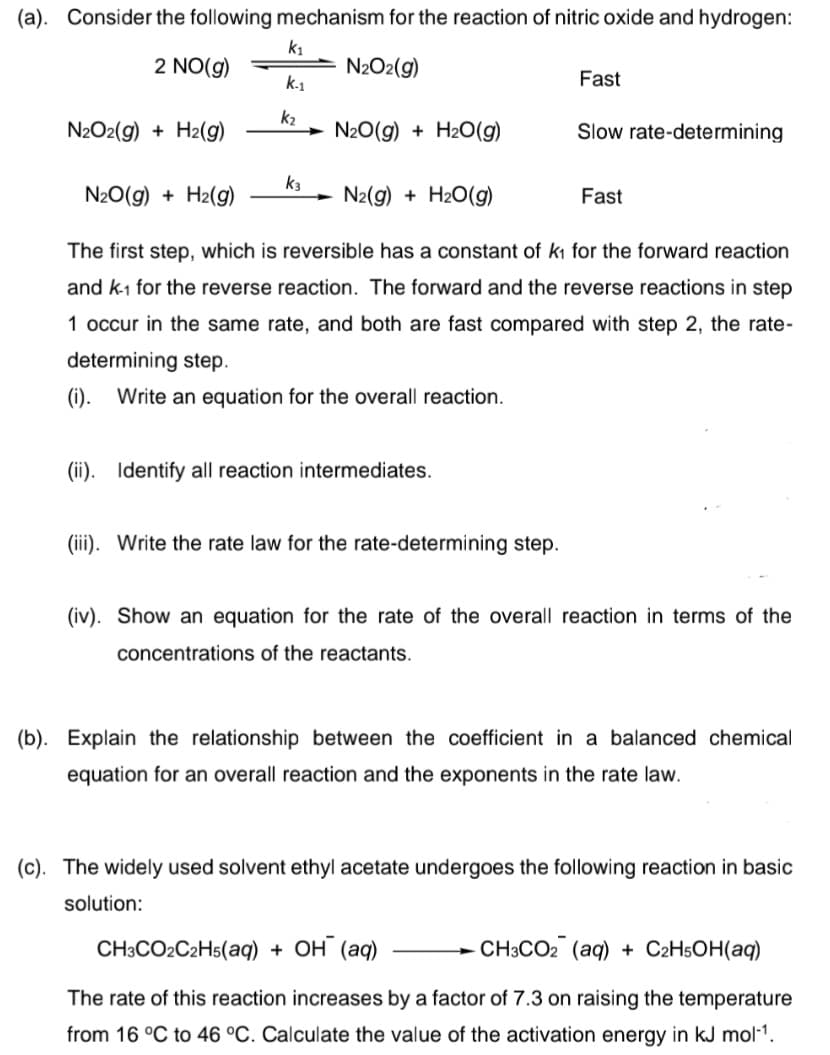(ii). Identify all reaction intermediates. (iii). Write the rate law for the rate-determining step. (iv). Show an equation for the rate of the overall reaction in terms of the concentrations of the reactants.
(ii). Identify all reaction intermediates. (iii). Write the rate law for the rate-determining step. (iv). Show an equation for the rate of the overall reaction in terms of the concentrations of the reactants.
Principles of Modern Chemistry
8th Edition
ISBN:9781305079113
Author:David W. Oxtoby, H. Pat Gillis, Laurie J. Butler
Publisher:David W. Oxtoby, H. Pat Gillis, Laurie J. Butler
Chapter18: Chemical Kinetics
Section: Chapter Questions
Problem 32P
Related questions
Question
Kindly answer question a ii, iii & iv

Transcribed Image Text:(a). Consider the following mechanism for the reaction of nitric oxide and hydrogen:
k1
2 NO(g)
N2O2(g)
k.1
Fast
k2
N2O2(g) + H2(g)
N20(g) + H2O(9)
Slow rate-determining
k3
N20(g) + H2(g)
N2(g) + H2O(g)
Fast
The first step, which is reversible has a constant of ki for the forward reaction
and k-1 for the reverse reaction. The forward and the reverse reactions in step
1 occur in the same rate, and both are fast compared with step 2, the rate-
determining step.
(i). Write an equation for the overall reaction.
(ii). Identify all reaction intermediates.
(iii). Write the rate law for the rate-determining step.
(iv). Show an equation for the rate of the overall reaction in terms of the
concentrations of the reactants.
(b). Explain the relationship between the coefficient in a balanced chemical
equation for an overall reaction and the exponents in the rate law.
(c). The widely used solvent ethyl acetate undergoes the following reaction in basic
solution:
CH3CO2C2H5(aq) + OH (aq)
CH:CO2 (аq) + C2H5ОН(аq)
The rate of this reaction increases by a factor of 7.3 on raising the temperature
from 16 °C to 46 °C. Calculate the value of the activation energy in kJ mol-1.
Expert Solution
This question has been solved!
Explore an expertly crafted, step-by-step solution for a thorough understanding of key concepts.
Step by step
Solved in 2 steps with 2 images

Knowledge Booster
Learn more about
Need a deep-dive on the concept behind this application? Look no further. Learn more about this topic, chemistry and related others by exploring similar questions and additional content below.Recommended textbooks for you

Principles of Modern Chemistry
Chemistry
ISBN:
9781305079113
Author:
David W. Oxtoby, H. Pat Gillis, Laurie J. Butler
Publisher:
Cengage Learning

Chemistry: An Atoms First Approach
Chemistry
ISBN:
9781305079243
Author:
Steven S. Zumdahl, Susan A. Zumdahl
Publisher:
Cengage Learning


Principles of Modern Chemistry
Chemistry
ISBN:
9781305079113
Author:
David W. Oxtoby, H. Pat Gillis, Laurie J. Butler
Publisher:
Cengage Learning

Chemistry: An Atoms First Approach
Chemistry
ISBN:
9781305079243
Author:
Steven S. Zumdahl, Susan A. Zumdahl
Publisher:
Cengage Learning


Chemistry
Chemistry
ISBN:
9781305957404
Author:
Steven S. Zumdahl, Susan A. Zumdahl, Donald J. DeCoste
Publisher:
Cengage Learning

Chemistry for Engineering Students
Chemistry
ISBN:
9781337398909
Author:
Lawrence S. Brown, Tom Holme
Publisher:
Cengage Learning

Chemistry by OpenStax (2015-05-04)
Chemistry
ISBN:
9781938168390
Author:
Klaus Theopold, Richard H Langley, Paul Flowers, William R. Robinson, Mark Blaser
Publisher:
OpenStax